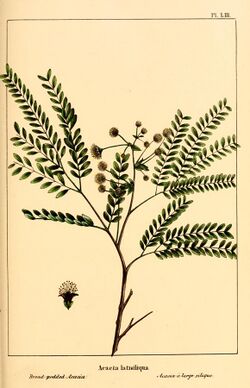Biology:Lysiloma latisiliquum
From HandWiki
Short description: Species of legume
| Lysiloma latisiliquum | |
|---|---|

| |
| Scientific classification | |
| Kingdom: | Plantae |
| Clade: | Tracheophytes |
| Clade: | Angiosperms |
| Clade: | Eudicots |
| Clade: | Rosids |
| Order: | Fabales |
| Family: | Fabaceae |
| Subfamily: | Caesalpinioideae |
| Clade: | Mimosoid clade |
| Genus: | Lysiloma |
| Species: | L. latisiliquum
|
| Binomial name | |
| Lysiloma latisiliquum (L.) Benth.
| |
| Synonyms | |
|
Acacia bahamensis (Benth.) Griseb. | |
Lysiloma latisiliquum, commonly known as false tamarind or wild tamarind, is a species of tree in the family Fabaceae, that is native to southern Florida in the United States, the Bahamas, Cuba, southern Mexico, and Belize.[1] Its wood is sometimes traded as sabicu wood.
References
- ↑ 1.0 1.1 Botanic Gardens Conservation International (BGCI).; IUCN SSC Global Tree Specialist Group (2019). "Lysiloma latisiliquum". IUCN Red List of Threatened Species 2019: e.T62020988A149016840. doi:10.2305/IUCN.UK.2019-2.RLTS.T62020988A149016840.en. https://www.iucnredlist.org/species/62020988/149016840. Retrieved 20 November 2021.
External links
Wikidata ☰ Q691530 entry
 |


